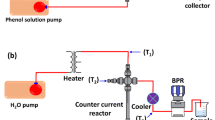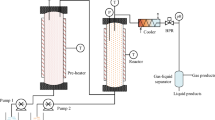Abstract
The supercritical water oxidation (SCWO) of o-dichlorobenzene (o-DCB) in a fused quartz capillary reactor was studied by in situ microscope combined with Raman spectroscopy. The influence of oxidant dosage, reaction temperature and time on the o-DCB degradation efficiency was investigated and the reaction kinetics for CO2 yield was explored as well. The obvious phase change of o-DCB-H2O/H2O2 system was observed during the heating and cooling process. The increase in H2O2 dosage, temperature and time enhanced the o-DCB degradation efficiency. The degradation of o-DCB could be attributed to the simultaneous oxidation induced by HO· and O2. The effect of temperature on the o-DCB degradation efficiency and the CO2 yield was not significant at the lower temperature stage but turned to be important at the higher temperature stage. When the oxidant dosage was twice that of chemometry and the temperature and time were 440.0 °C and 4 min, respectively, the o-DCB degradation efficiency reached approximately 100%. Under the same conditions, the CO2 yield was lower than the o-DCB degradation efficiency, indicating that the degradation of o-DCB was a multi-step reaction. The reaction kinetics showed that the kinetics of CO2 production in SCWO followed the pseudo-first order and the apparent activation energy was 172.4 kJ mol−1.







Similar content being viewed by others
References
Abeish AM, Ang HM, Znad H (2015) Solar photocatalytic degradation of chlorophenols mixture (4-CP and 2,4-DCP): mechanism and kinetic modelling. J Environ Sci Health A 50:125–134
Bei K, Zhang C, Wang JL (2016) Solubility and dissolution mechanism of 4-chlorotoluene in subcritical water investigated in a fused silica capillary reactor by in situ Raman spectroscopy. Fluid Phase Equilib 425:93–97
Černá A, Hruška B, Tokarčíková D, Chromčíková M, Liška M (2018) Optical microscopy, Raman spectroscopy, and AFM study of heavy weathered surface of barium crystal glass. Chem Pap 72:2153–2158
Christensen H, Sehested K (1983) Reaction of hydroxyl radicals with hydrogen at elevated temperatures. Determination of the activation energy. J Phys Chem 14:118–120
Christensen H, Sehested K, Corfitzen H (1982) Reactions of hydroxyl radicals with hydrogen peroxide at ambient and elevated temperatures. (10 MeV electrons). J Phys Chem 86:1588–1590
Croiset E, Rice SF, Hanush RG (1997) Hydrogen peroxide decomposition in supercritical water. AIChE J 43:2343–2352
Gemoets HP, Su Y, Shang M, Hessel V, Luque R, Noel T (2016) Liquid phase oxidation chemistry in continuous-flow microreactors. Chem Soc Rev 45:83–117
Gole VL, Gogate PR (2015) Intensification of sonochemical degradation of chlorobenzene using additives. Desalination Water Treat 53:2623–2635
Hashimoto M, Taniguchi S, Takanami R, Giri RR, Ozaki H (2010) Oxidative degradation of 2,4-dichlorophenoxyacetic acid (2,4-D) in subcritical and supercritical waters. Water Sci Technol 62:484–490
Kim JK, Metcalfe IS (2007) Investigation of the generation of hydroxyl radicals and their oxidative role in the presence of heterogeneous copper catalysts. Chemosphere 69:689–696
Li R, Thornton TD, Savage PE (1992) Kinetics of carbon dioxide formation from the oxidation of phenols in supercritical water. Environ Sci Technol 26:2388–2395
Lin CM, Zhou HY, Pan ZY, Zhang YC, Jin YM (2000) Study on decomposition of phenol by supercritical water oxidization. Res Environmentalences 13(2):1–2
Marrone PA (2013) Supercritical water oxidation—current status of full-scale commercial activity for waste destruction. J Supercrit Fluid 79:283–288
Marta OZ, Wawrzynczak D, Wachowiak R, Trzeciak WH (2010) Accumulation of environmental estrogens in adipose tissue of breast cancer patients. J Environ Sci Health A 45:305–312
Pan ZY, Dong Z (2011) Determination of chlorobenzene solubilities in subcritical water in a fused silica capillary reactor from 173 to 267 °C. Ind Eng Chem Res 50:11724–11727
Pan ZY, Lin CM, Zhou HY, Yang K (2003) Oxidative degradation kinetics of acetic acid in the supercritical water. J Chem Eng Chin Univ 17:101–105
Pan ZY, Ma Y, Chou IM (2013) Solubility of 2,4-dichlorotoluene in water determined in fused silica capillary reactor by in situ Raman spectroscopy. AIChE J 59:2721–2725
Qi XH, Zhuang YY, Yuan YC, Gu WX (2002) Decomposition of aniline in supercritical water. J Hazard Mater 90:51–62
Seok OK, Sun YJ, Do HL, Jaewoo P, Won SS (2007) Effects of oxidative coupling reaction of 4-chlorophenol with manganese oxide on the phenanthrene sorption. J Environ Sci Health A 42:257–263
Seung HH, Bambang V, Jae DK, Jong CL (2007) Pentachlorophenol oxidation rates in supercritical water. J Environ Sci Health A 42:2105–2109
Veriansyah B, Kim JD, Lee JC, Hong D (2006) Destruction of OPA from munitions demilitarization in supercritical water oxidation: kinetics of total organic carbon disappearance. J Environ Sci Health A 41:1559–1568
Wang JL, Zhou SY, Bei K et al (2017) Using fused silica capillary cell and in situ Raman spectroscopy to develop a set-up for measurement the volume expansion of carbon dioxide + n-hexane. Energy Fuel 31:6314–6319
Yan DZ, Mao LQ, Li CZ, Liu J (2015) Biodegradation of hexachlorobenzene by a constructed microbial consortium. World J Microbiol Biotechnol 31:371–377
Yao X, Zhang Y, Du L, Liu J, Yao J (2015) Review of the applications of microreactors. Renew Sust Energy Rev 47:519–539
Zhang H, Han DD, Yi C, Lin CM (2016) Catalysis of CuSO4 for total organic carbon detection based on supercritical water oxidation. Water Sci Technol 74:295
Acknowledgements
The authors are grateful for the financial support from the Natural Science Foundation of China (Grant no. 21377116).
Author information
Authors and Affiliations
Corresponding author
Ethics declarations
Conflict of interest
The authors declare no competing financial interest.
Rights and permissions
About this article
Cite this article
Lin, CM., Liu, H., Zhen, WS. et al. Study on supercritical water oxidation of o-dichlorobenzene in a quartz micro-reactor with in situ microscope and Raman spectroscopy. Chem. Pap. 73, 1257–1262 (2019). https://doi.org/10.1007/s11696-018-00676-8
Received:
Accepted:
Published:
Issue Date:
DOI: https://doi.org/10.1007/s11696-018-00676-8




